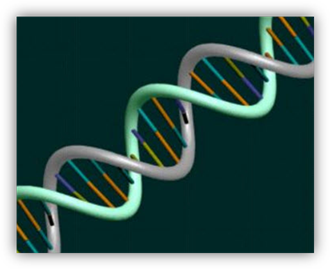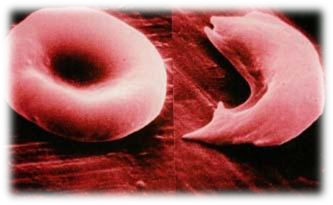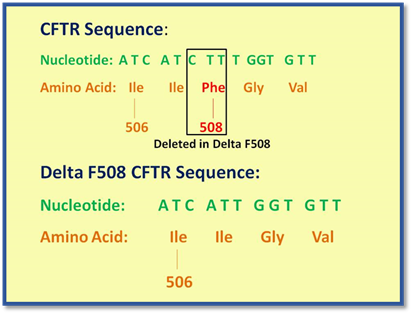
GENE
MUTATION
You have learned the structure of DNA and RNA, and how
DNA and RNA work in transcription and translation with the goal of making a
protein. We will now discuss some of the mistakes that can happen with DNA and
the sequence it holds which may affect the organism. A mutation is any change in the structure or amount of genetic
material (DNA or RNA). When a mutation occurs in DNA it affects the
transcription of the RNA sequence which then affects the translation of the
protein. Mutations may harm the organism, help the organism, or have no effect
on the organism and go unnoticed. A mutation can be beneficial, as in modifying
an organism to better adapt to an environment, or harmful, as in negatively
changing a structure or function within an organism.
We have already discussed large scale mutations that
concern chromosomes. Now, we will examine smaller scale mutations which may
have a great effect on the organism. You should recall, in DNA replication, how
DNA polymerase acts as a
proof-reading enzyme to correct any mistakes that happened in the replication
process. Sometimes, DNA polymerase will miss a mistake and let it pass to the
daughter cells.
Possible changes in the DNA, or mutations, can happen
naturally as an accidental change, or can be increased in likelihood by environmental
factors. A mutagen is anything that
causes a mutation. Some environmental factors that act as mutagens are
different forms of radiation (ultraviolet & X-rays), some chemicals
(benzene), and some biological agents (viruses & bacteria).
Mutations can occur in any type of cell. A mutation
that affects the gametes (sperm and
egg) is known as germ-cell mutation.
Since this type of mutation alters the DNA of the cells that will produce the
zygote, these mutations are passed on to the offspring. A germ-cell mutation
will not affect the organism itself, only the future organism it may possibly
produce. A mutation that affects any of the body
cells (any other cell besides a gamete) is known as a somatic mutation. A somatic mutation will not be passed on to the
offspring, but will affect the organism with the mutation.
|
Mutations
that result as a change in the DNA Sequence |
||||
|
Mutation
Type |
Point
Mutation (Substitution) |
Insertion |
Deletion |
|
|
Mutation
Description |
Involves a change of a single nucleotide. |
Involves a nucleotide that is added into the DNA
sequence. |
Involves a nucleotide that has been removed from the
DNA sequence. |
|
|
Mutation
Example |
Original DNA Sequence |
A-C-G-T |
A-C-G-T |
A-C-G-T |
|
Mutated DNA Sequence |
A-C-T-T |
A-C-G-C-T |
A-G-T |
|
|
Mutations that result as a change
in the Gene |
||||
|
Use the “Original DNA sequence”,
“mRNA sequence”, and “amino acid sequence” below as a comparison for the
different types of mutations listed below. |
||||
|
Original
DNA Sequence (as codons) |
CGG |
GGG |
TCA |
CCT |
|
mRNA
Sequence (from transcription) |
GCC |
CCC |
AGU |
GGA |
|
Amino
Acid Sequence (from translation) |
Alanine |
Proline |
Serine |
Glycine |
|
Silent
Mutation |
A
DNA mutation that has no effect on a gene’s function or amino acid coding.
Notice the point mutation that took place in the third nucleotide of the
first codon. Changing the third nucleotide, in this case, had no effect on
the originally intended amino acid as it is still coding for alanine. |
|||
|
Mutated DNA Sequence |
CGT |
GGG |
TCA |
CCT |
|
New mRNA Sequence |
GCA |
CCC |
AGU |
GGA |
|
New Amino Acid Sequence |
Alanine |
Proline |
Serine |
Glycine |
|
Missense
(Replacement) Mutation |
A
DNA mutation that changes one codon to code for a different amino acid.
Notice the point mutation that took place in the second nucleotide of the
third codon. Changing the second nucleotide, in this case, has an effect on
the originally intended amino acid. This mutation now calls for the codon to
code for isoleucine instead of serine. |
|||
|
Mutated DNA Sequence |
CGG |
GGG |
TAA |
CCT |
|
New mRNA Sequence |
GCC |
CCC |
AUU |
GGA |
|
New Amino Acid Sequence |
Alanine |
Proline |
Isoleucine |
Glycine |
|
Frameshift
Mutation (Due to insertion) |
A
DNA mutation that shifts the entire DNA sequence from the point of the
mutation forward. Notice the insertion mutation that took
place in the first nucleotide of the second codon. Adding a nucleotide, in
this case, has an effect on the originally intended amino acid and every
amino acid from that point onward. |
|||
|
Mutated DNA Sequence |
CGG |
AGGG |
TCA |
CCT |
|
New mRNA Sequence |
GCC |
UCCC |
AGU |
GGA |
|
New Amino Acid Sequence |
Alanine |
Serine |
Glutamine |
Tryptophan |
|
Frameshift
Mutation (Due to deletion) |
A
DNA mutation that shifts the entire DNA sequence from the point of the
mutation forward. Notice the deletion mutation that took
place in the first nucleotide of the second codon. Deleting a nucleotide, in
this case, has an effect on the originally intended amino acid and every
amino acid from that point onward. |
|||
|
Mutated DNA Sequence |
CGG |
GG |
TCA |
CCT |
|
New mRNA Sequence |
GCC |
CC |
AGU |
GGA |
|
New Amino Acid Sequence |
Alanine |
Proline |
Valine |
Unknown until third nucleotide is
identified |
|
Nonsense
Mutation |
A
DNA mutation that changes one codon to a stop codon.
Notice the point mutation that took place in the first nucleotide of the
fourth codon. Changing the first nucleotide, in this case, has an effect on
the originally intended amino acid. This mutation now calls for a stop codon
to suddenly stop the translating of this code. |
|||
|
Mutated DNA Sequence |
CGG |
GGG |
TCA |
ACT |
|
New mRNA Sequence |
GCC |
CCC |
AGU |
UGA |
|
New Amino Acid Sequence |
Alanine |
Proline |
Isoleucine |
STOP |
|
The following video focuses on mutations that can
occur in DNA, which take place when an issue occurs with a nucleotide.
Missense and nonsense mutations occur when one nucleotide is simply changed
to another. Frameshift mutations are the result of a nucleotide being
inserted or deleted, altering the rest of the codons. Synonymous
substitutions are mutations in which a nucleotide is changed, but it does not
impact the meaning of the codon. |
||||
We can use the statement “the fat cat sat” to help you understand some of these mutations. A
missense (replacement) mutation would
have a letter change in a word that would therefore change the word, as in
changing the “a” in “cat” to an “e”. Changing the word now results in a strange
unknown meaning (“the fat cet sat”),
just as changing an amino acid would change the protein. A frameshift mutation (due to insertion) would have a letter added to
a word, which would shift the letters in all of the three letter words from the
point of the addition forward. This is demonstrated by adding the letter “a” in
front of “fat” (“the afa tca tsa t”).
A frameshift mutation (due to deletion)
would have a letter removed from a word, which would shift the letters in all
of the three letter words from the point of the deletion forward. This is
demonstrated by removing the letter “f” from “fat” (“the atc ats at”). A nonsense
mutation would have one of the words replaced with a period (stop codon)
which ends the statement abruptly with no meaning as in replacing “cat” with a
period (“the fat.”).
Sickle Cell Anemia Research

Sickle Cell Anemia is a genetic disease caused by a
point mutation which results in a missense mutation. The mutation cause the
original codon of GAG to change to GTG on chromosome 11. The change in one base
of the codon goes from coding for the amino acid glutamic acid to the amino
acid valine which dramatically changes the protein found in the blood. Visit
the link below to learn more about sickle cell anemia and how it affects an
individual.
http://learn.genetics.utah.edu/content/disorders/singlegene/
![]() Genetic Disease:
What is Sickle Cell Anemia?
Genetic Disease:
What is Sickle Cell Anemia?
 Cystic
Fibrosis Research
Cystic
Fibrosis Research
Cystic Fibrosis is a genetic disease caused by many
different mutations. There are different classes of cystic fibrosis based on
what type of mutation is involved. The most common mutation found in about 70%
of cystic fibrosis genes is a deletion mutation (known as Delta F508). The
deletion involves removing three nucleotides (or one codon) which coded for
phenylalanine. Visit the link below to learn more about cystic fibrosis and how
it affects an individual.
http://learn.genetics.utah.edu/content/disorders/singlegene/
Unit
17 Worksheet Gene Mutations
UNIT VOCABULARY
REVIEW
Click on the Quizlet icon below to access the quizlet.com vocabulary flash
cards. Review the vocabulary before completing your assessment.
 Now answer questions 1 through 20.
Now answer questions 1 through 20.
